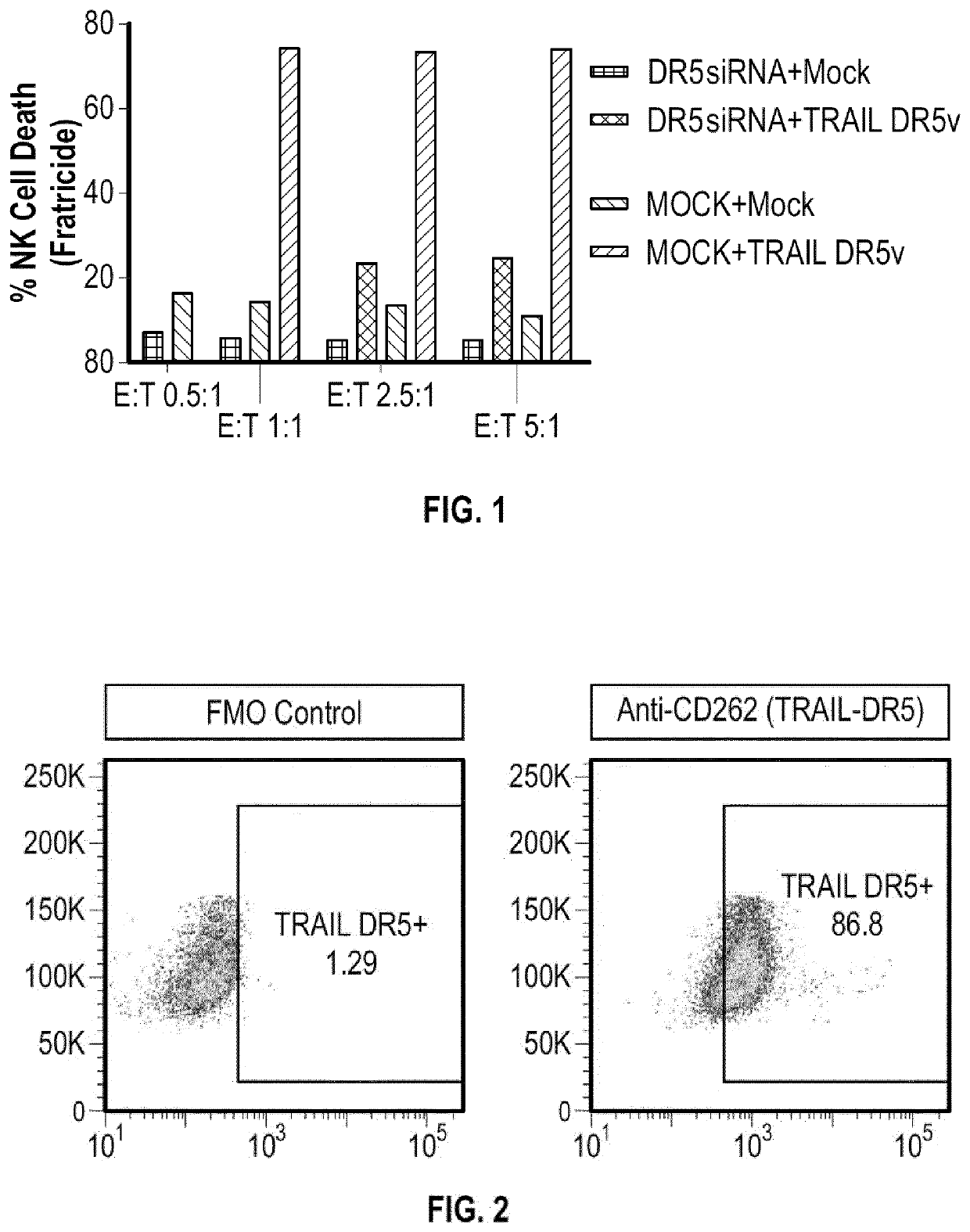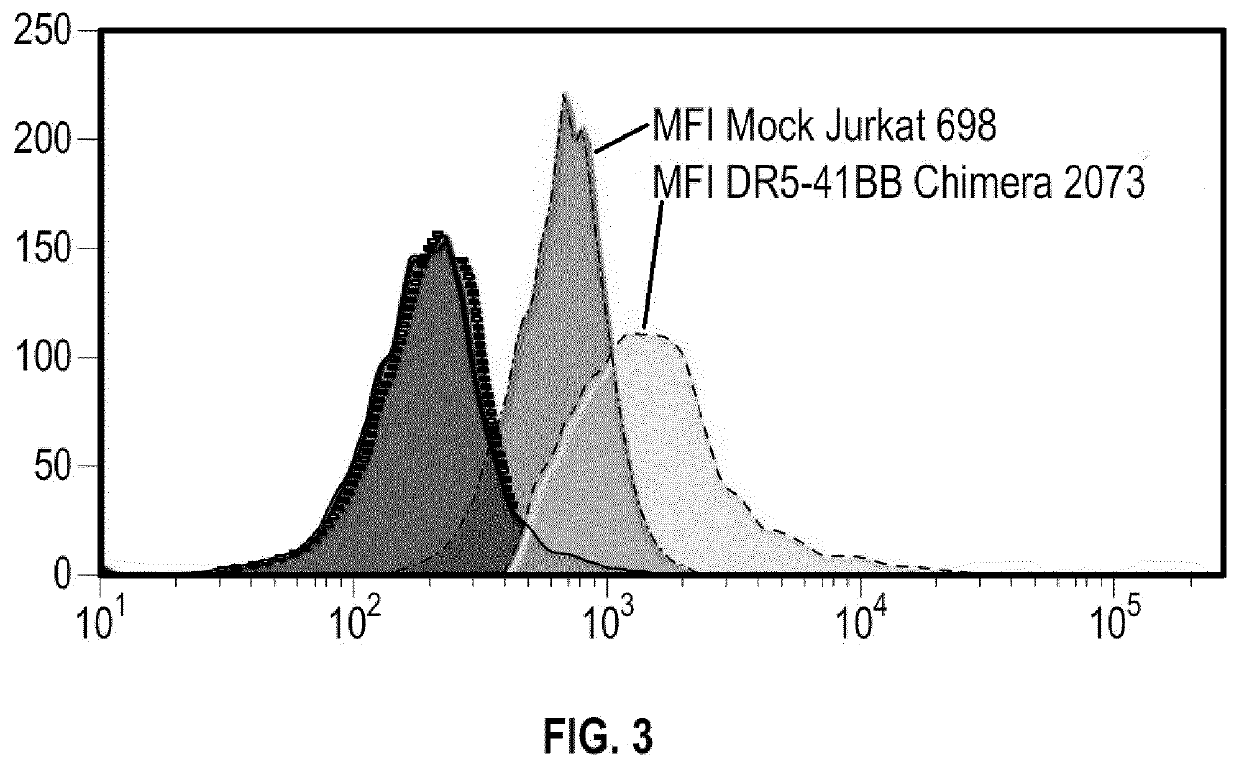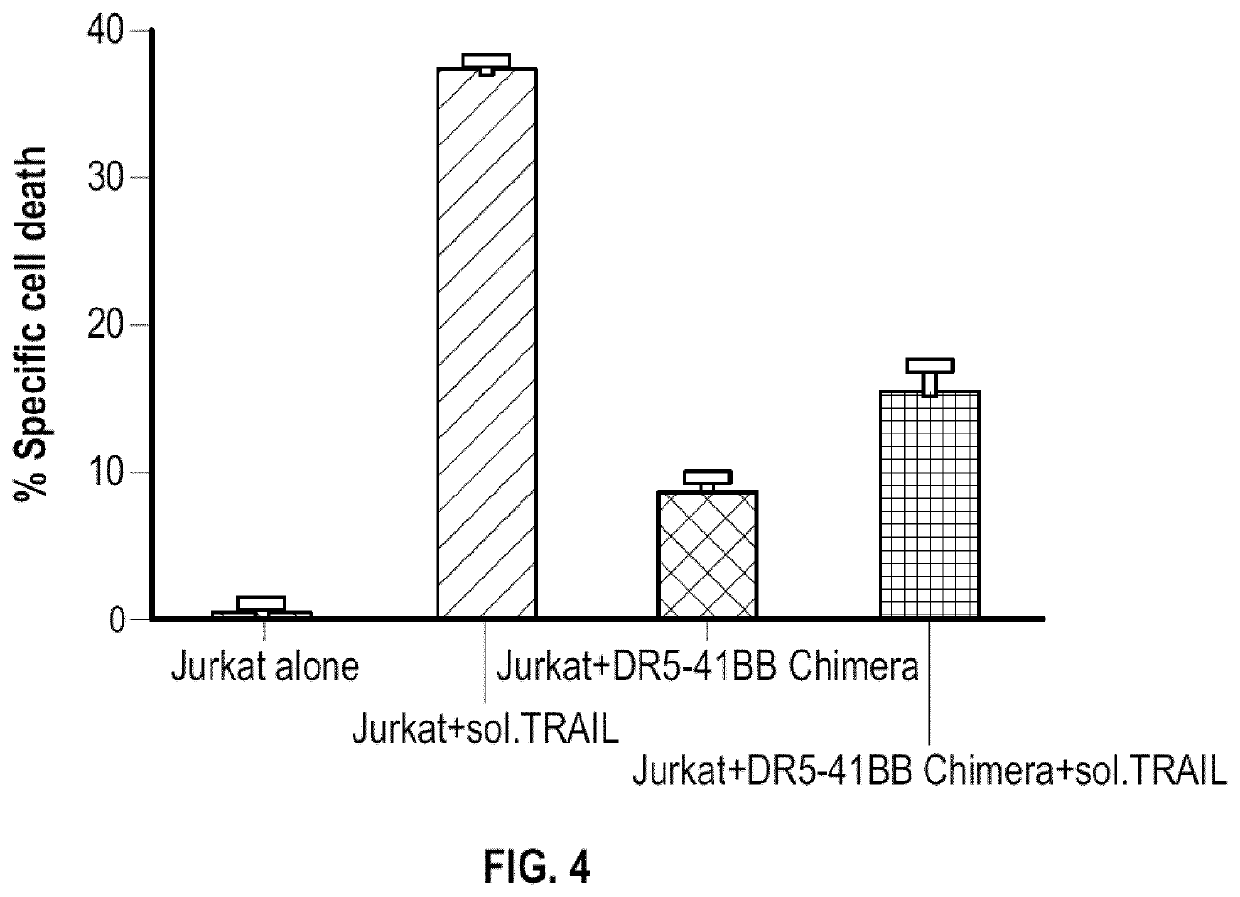Modified immune effector cells with increased resistance to cell death
a technology of immune effector cells and cell death, which is applied in the field of modified immune effector cells with increased resistance to cell death, can solve the problems of reducing the expression of nkg2a, the target cell death, and the increase in cytotoxicity associated with reducing nkg2a expression might have been too trivial to detect, and achieves the effect of more cytotoxic phenotyp
- Summary
- Abstract
- Description
- Claims
- Application Information
AI Technical Summary
Benefits of technology
Problems solved by technology
Method used
Image
Examples
example 1
of NK Cell TRAIL Receptors DR4 and DR5
[0140]NK Cells are prepared as follows, having death receptor 5 (DR5) and / or death receptor 4 (DR4) function removed.
[0141]gRNA constructs targeting TRAIL-R2 (DR5) and TRAIL-R1 (DR4) are designed
(e.g.SEQ ID NO: 1: CCCAUCUUGAACAUACCAG (DR5),SEQ ID NO: 2: AACCGGUGCACAGAGGGUGU (DR4)andSEQ ID NO: 3: AUUUACAAGCUGUACAUGGG (DR4))
[0142]and prepared to target endogenous genes encoding DR5 and DR4 gene(s) in NK cells. CRISPR / Cas9 genome editing is then used to knock out the DR5 and / or DR4 target genes.
[0143]A total of 3 gRNA candidates are selected for the DR5 gene and their cleavage efficacies in RPMI8226 cells determined. A total of 3 gRNA candidates are selected for the DR4 gene and their cleavage efficacies in HL60 cells determined. RPMI8226 cells and HL60 are electroporated with the gRNA:Cas9 ribonucleoprotein (RNP) complex using Maxcyte® GT and subsequently knockout of DR5 and / or is analyzed by flowcytometry. The cleavage activity of the gRNA is als...
example 2
of TRAIL Receptors DR4 and DR5 in NK Cells
[0145]siRNA knockdown of DR4 and / or DR5 in NK-92 cells, KHYG-1 cells and primary NK cells is performed by electroporation. The Nucleofection Kit T can be used, in conjunction with the Amaxa Nucleofector II, from Lonza, as it is appropriate for use with NK cells and can successfully transfect both dividing and non-dividing cells and achieves transfection efficiencies of up to 90%.
[0146]The Nucleofector solution is warmed to room temperature (100 ul per sample). An aliquot of culture medium containing serum and supplements is also pre-warmed at 37° C. in a 50 ml tube. 6-well plates are prepared by adding 4 ml of culture medium containing serum and supplements. The plates are pre-incubated in a humidified 37° C. / 5% CO2 incubator.
[0147]2×106 cells in 100 μl Nucleofection solution are mixed gently with 20 μM siRNA solution to achieve a final concentration of 2 μM. Air bubbles are avoided during mixing. The mixture is transferred into Amaxa certif...
example 3
DR5-CD28 Fusion Proteins
[0150]The immunomodulatory fusion proteins (IFPs) may comprise the extracellular domain of DR4 or DR5, or a portion thereof, and an intracellular signaling domain of CD28, or a portion thereof. The hydrophobic component may be comprised of the transmembrane domain of either DR4 / DR5 or CD28, or portions thereof. In some DR4-CD28 or DR5-CD28 fusion proteins, the hydrophobic component comprises the transmembrane domain of CD28 and the extracellular component further comprises an extracellular portion of CD28, specifically an extracellular cysteine residue adjacent to the hydrophobic component. The extracellular component may comprise all or a portion of the extracellular domain of DR4 or DR5.
[0151]The extracellular component may comprise the entire extracellular domain of DR4 / DR5. The DR4-CD28 or DR5-CD28 constructs thus have the capacity to convert what would typically be an inhibitory signal from the binding of either DR4 or DR5 to TRAIL into a positive signal...
PUM
| Property | Measurement | Unit |
|---|---|---|
| concentration | aaaaa | aaaaa |
| concentration | aaaaa | aaaaa |
| concentration | aaaaa | aaaaa |
Abstract
Description
Claims
Application Information
 Login to View More
Login to View More - R&D
- Intellectual Property
- Life Sciences
- Materials
- Tech Scout
- Unparalleled Data Quality
- Higher Quality Content
- 60% Fewer Hallucinations
Browse by: Latest US Patents, China's latest patents, Technical Efficacy Thesaurus, Application Domain, Technology Topic, Popular Technical Reports.
© 2025 PatSnap. All rights reserved.Legal|Privacy policy|Modern Slavery Act Transparency Statement|Sitemap|About US| Contact US: help@patsnap.com



